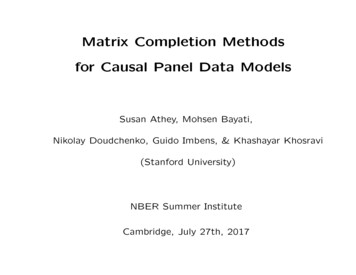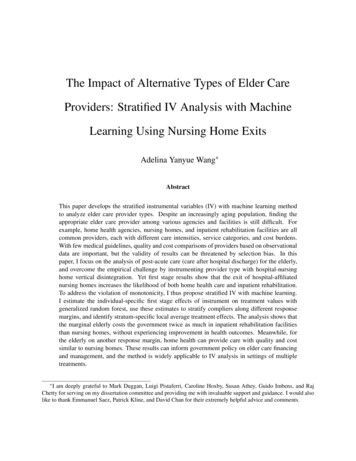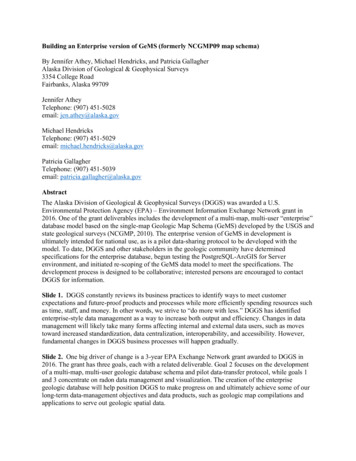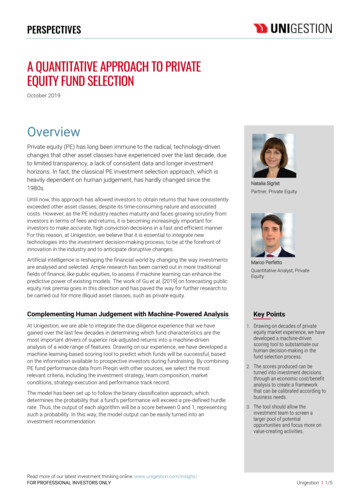
Transcription
Machine Learning Methods for Estimating Heterogeneous CausalEffects arXiv:1504.01132v1 [stat.ML] 5 Apr 2015Susan Athey†Guido W. Imbens‡First Draft: October 2013This Draft: April 2015AbstractIn this paper we study the problems of estimating heterogeneity in causal effects inexperimental or observational studies and conducting inference about the magnitude ofthe differences in treatment effects across subsets of the population. In applications, ourmethod provides a data-driven approach to determine which subpopulations have large orsmall treatment effects and to test hypotheses about the differences in these effects. Forexperiments, our method allows researchers to identify heterogeneity in treatment effectsthat was not specified in a pre-analysis plan, without concern about invalidating inferencedue to multiple testing. In most of the literature on supervised machine learning (e.g.regression trees, random forests, LASSO, etc.), the goal is to build a model of the relationshipbetween a unit’s attributes and an observed outcome. A prominent role in these methods isplayed by cross-validation which compares predictions to actual outcomes in test samples, inorder to select the level of complexity of the model that provides the best predictive power.Our method is closely related, but it differs in that it is tailored for predicting causal effectsof a treatment rather than a unit’s outcome. The challenge is that the “ground truth” for acausal effect is not observed for any individual unit: we observe the unit with the treatment,or without the treatment, but not both at the same time. Thus, it is not obvious how touse cross-validation to determine whether a causal effect has been accurately predicted. Wepropose several novel cross-validation criteria for this problem and demonstrate throughsimulations the conditions under which they perform better than standard methods forthe problem of causal effects. We then apply the method to a large-scale field experimentre-ranking results on a search engine.Keywords: Potential Outcomes, Heterogeneous Treatment Effects, Causal Inference, Supervised Machine Learning, Cross-Validation We are grateful for comments provided at seminars at the Southern Economics Association, Microsoft Research, the University of Pennsylvania, the University of Arizona, the Stanford Conferenceon Causality in the Social Sciences, and The MIT Conference in Digital Experimentation. Part of thisresearch was conducted while the authors were visiting Microsoft Research.†Graduate School of Business, Stanford University, and NBER. Electronic correspondence:athey@stanford.edu‡Graduate School of Business, Stanford University, and NBER. Electronic correspondence: imbens@stanford.edu[1]
1IntroductionIn this paper we study two closely related problems: first, estimating heterogeneity by featuresin causal effects in experimental or observational studies, and second, conducting inferenceabout the magnitude of the differences in treatment effects across subsets of the population.Causal effects, in the Rubin Causal Model or potential outcome framework that we use here(Rubin, 1976, 1978; Imbens and Rubin, 2015), are comparisons between outcomes we observeand counterfactual outcomes we would have observed under a different regime or treatment.We introduce a method that provides a data-driven approach to select subpopulations withdifferent average treatment effects and to test hypotheses about the differences between theeffects in different subpopulations. For experiments, our method allows researchers to identifyheterogeneity in treatment effects that was not specified in a pre-analysis plan, without concernabout invalidating inference due to concerns about multiple testing.Our approach is tailored for applications where there may be many attributes of a unitrelative to the number of units observed, and where the functional form of the relationshipbetween treatment effects and the attributes of units is not known. We build on methods fromsupervised machine learning (see Hastie, Tibshirani, and Friedman (2011) for an overview).This literature provides a variety of very effective methods for a closely related problem, theproblem of predicting outcomes as a function of covariates in similar environments. The mostpopular methods (e.g. regression trees, random forests, LASSO, support vector machines, etc.)entail building a model of the relationship between attributes and outcomes, with a penaltyparameter that penalizes model complexity. To select the optimal level of complexity (the onethat maximizes predictive power without “overfitting”), the methods rely on cross-validation.The cross-validation approach compares a set of models with varying values of the complexitypenalty, and selects the value of complexity parameter for which out-of-sample predictions bestmatch the data using a criterion such as mean squared error (MSE). This method works wellbecause in the test sample, the “ground truth” is known: we observe each unit’s outcome, sothat we can easily assess the performance of the model.Our method is closely related to this approach, but it differs in that it is tailored forpredicting causal effects of a treatment rather than a unit’s outcome. We directly build themodel that best predicts how treatment effects vary with the attributes of units. The challengein applying the machine learning methods “off the shelf” is that the “ground truth” for acausal effect is not observed for any individual unit: we observe the unit with the treatment, orwithout the treatment, but not both at the same time, which is what Holland (1986) calls the“fundamental problem of causal inference.” Thus, it is not obvious how to use cross-validationto determine whether a causal effect has been accurately predicted. We propose several novelcross-validation criteria for this problem and demonstrate through simulations the conditionsunder which they perform better than standard methods for the problem of causal effects.We then apply the method to applications, including a large-scale field experiment on votingand a large-scale field experiment re-ranking results on a search engine. Although we focus inthe current paper mostly on regression tree methods (Breiman, Friedman, Olshen, and Stone,1984), the methods extend to other approaches such as Lasso (Tibshirani, 1996), and support[1]
vector machines (Vapnik, 1998, 2010).22.1The ProblemThe Set UpWe consider a setup where either we have data from an experiment where a binary treatment isassigned randomly to units conditional on their observables, or where we have an observationalstudy that satisfies the assumptions for “uncounfoundedness” or “selection on observables,”(Rosenbaum and Rubin, 1983; Imbens and Rubin, 2015) There are N units, indexed by i 1, . . . , N . Let Wi {0, 1} be the binary indicator for the treatment, with Wi 0 indicatingthat unit i received the control treatment, and Wi 1 indicating that unit i received theactive treatment, and let Xi be a L-component vector of features, covariates or pretreatmentvariables, known not to be affected by the treatment. Let p pr(Wi 1) E[Wi ] bethe marginal treatment probability, and let e(x) pr(Wi 1 Xi x) be the conditionaltreatment probability (the “propensity score” as defined by Rosenbaum and Rubin (1983)).In a randomized experiment with constant treatment assignment probabilities e(x) p for allvalues of x.We assume that observations are exchangeable, and that there is no interference (the stableunit treatment value assumption, or sutva, Rubin, 1978). This assumption may be violatedin network settings where some units are connected, or in settings where general equilibriumeffects are important (Athey, Barrios, Eckles and Imbens, 2015). We postulate the existenceof a pair of potential outcomes for each unit, (Yi (0), Yi (1)) (following the potential outcome orRubin Causal Model, Rubin, 1977; Holland, 1986, Imbens and Rubin, 2015), with the unit-levelcausal effect defined as the difference in potential outcomes,τi Yi (1) Yi (0).The realized and observed outcome for unit i is the potential outcome corresponding to thetreatment received: Yi (0)if Wi 0,obsYi Yi (Wi ) Yi (1)if Wi 1.Our data consist of the triple (Yiobs , Wi , Xi ), for i 1, . . . , N , which are regarded as an i.i.dsample drawn from an infinite superpopulation. Expectations and probabilities will refer to thedistribution induced by the random sampling, or by the (conditional) random assignment ofthe treatment.Define the conditional average treatment effect (CATE)τ (x) E[Yi (1) Yi (0) Xi x],(2.1)and the population average treatment effectτ p E[Yi (1) Yi (0)] E[τ (Xi )].[2]
A large part of the causal inference literature (Imbens and Rubin, 2015; Pearl, 2000; Hernánand Robins, 2015; Morgan and Winship, 2014) is focused on estimating the population averagetreatment effect τ p . The main focus of the current paper is on obtaining accurate estimates ofthis conditional average treatment effect τ (x) for all values of x. The dimension of the covariatesmay be relatively large, and the covariates may be continuous or multi-valued, so we cannotsimply partition the covariate space into subsets within which the covariates are constant.There are a variety of reasons that researchers wish to conduct estimation and inferenceon the function τ (x). It may be used to assign future units to their optimal treatment, e.g.,Wiopt 1τ (Xi ) 0 . For example, if the treatment is a drug, we may only want to prescribe it tothe subpopulation that benefits from it. Since the cost of the drug as well as the benefits ofalternative drugs might be difficult to predict in advance, it is useful to know how the magnitudeof the benefits vary with attributes of individuals in order to conduct cost-benefit analysis in thefuture. In addition, it might be that the population average effect of the drug is not positive,but that the drug is effective for particular categories of patients. Typically for clinical trials,researchers are required to pre-specify how they will analyze the data, to avoid concerns aboutmultiple testing (whereby the researchers might conduct a large number of hypothesis tests forheterogeneous treatment effects, and we expect that some of those will show positive resultseven if the true effect is zero). A principled approach to estimating and conducting inferenceabout τ (x) would allow such researchers to discover populations that do indeed benefit, even ifthey didn’t have the foresight to specify this group as a subpopulation of interest in advance.We may also be interested in the relative value of observing and basing decisions on different sets of covariates. For example, consider the policy of giving the treatment to thoseunits associated with the covariates x that have the highest estimates of τ (x). The gain,in terms of expected outcomees, of such optimal assignment compared to uniform assignment is what we call the return to optimal treatment assignment for a particular set ofcovariates. Let µc (x) E[Yi (0) Xi x] and µt (x) E[Yi (1) Xi x]. Now let θ0 max(E[µc (Xi ), E[µt (Xi )]) be the maximum achievable average outcome given uniform assignment, and let θx E[max(µc (Xi ), µt (Xi )] be the maximum average outcome given optimalassignment based on the covariate x.The return to optimal treatment assignment based on x, relative to using no covariates, is rx θx θ0 1τ p 0 · E 1τ (Xi ) 0 · τ (Xi ) 1τ p 0 · E 1τ (Xi ) 0 · τ (Xi ) .Now compare this return to optimal treatment assignment based on x alone to that based on aricher set of covariates, say (x, x0 ). We may be interested in comparing rx with r(x,x0 ) to assesswhether we should invest in estimating a system that assigns units to treatment based on xand x0 rather than based on x alone.33.1Estimating Conditional Average Treatment EffectsThe ProblemThe goal is to develop an algorithm that generally leads to an accurate approximation τ̂ (x)to the conditional average treatment effect τ (x). Ideally we would measure the quality of the[3]
approximation in terms of the goodness of fit, e.g., minus the expected squared error 2 E τ̂ (Xi ) τ (Xi ).The problem, of course, is that we do not know τ (·), and so cannot directly compare differentestimators τ̂ (·) based on this criterion.The general class of algorithms we consider has the following structure, common in thesupervised learning literature. We consider a sequence of models of increasing complexity. Wechoose a method for estimating or training any model in that sequence given a training sample.We then compare the in-sample goodness-of-fit of the model with others in the sequence ofmodels, adding to the in-sample goodness-of-fit measure a penalty term that increases withthe complexity of the model. The penalty term involves a free parameter that determines howmuch increased complexity of the model is penalized. This parameter is chosen through out-ofsample cross-validation. Finally, different algorithms may be compared through out-of-samplegoodness-of-fit measures on a test sample.For the case where the goal is to construct an algorithm for a conditional expectation,µ(x) E[Yiobs Xi x], which is the focus of conventional supervised-learning literature, manysuch algorithms have been proposed. See, for example, Hastie, Tibshirani and Friedman (2011).Such algorithms may involve splitting the sample based on feature values (building regressiontrees), where given a set of splits the conditional expectation within each leaf of the tree isestimated by the sample average within that leaf. The in-sample goodness-of-fit measure is thenegative of the sum of squared deviations of the outcomes from these within-leaf averages. Aconventional penalty term is a constant times the number of splits/leaves, with the constantchosen through out-of-sample cross-validation. The out-of-sample goodness-of-fit measure isthe sum of squared deviations from the predicted values in the test sample.The principal problem addressed in the current paper is that this approach does not extenddirectly to the case where the object of interest is the conditional average treatment effectbecause the conditional average treatment effect is not a conditional expectation of a variable weobserve for all units in the sample. Specifically, given a candidate estimator for the conditionalexpectation τ (x), say τ̂ (x), we cannot measure the out-of-sample goodness-of-fit as minus thesum of deviations in the test sample,infeasQN te 21 X teYi (1) Yi (0) τ̂ (Xi ) .Ni 1This criteria is infeasible because we do not observe the values of the unit-level causal effectsτi Yi (1) Yi (0) for any unit in the population.3.2The Structure of Supervised Learning Algorithms Using Cross-Validationfor Model SelectionOur method follows the general structure of supervised learning algorithms that rely on crossvalidation for model selection. We decompose this structure, which is common across a wide[4]
range of conventional machine learning methods, into five components: (i) a sequence of possiblemodels of greater complexity that will be considered; (ii) the method for estimation or trainingof a given model on the training sample; (iii) the in-sample goodness-of-fit measure to rank themodels in the set of models considered on the training sample; (iv) the out-of-sample goodnessof-fit measure that is used to rank multiple candidate models for estimating conditional averagetreatment effects on the test sample; (v) the form of the penalty function that operates on eachmodel and the choice of the tuning parameters in that penalty function.Consider initially what these five components look like in the conventional case where thegoal is to estimate a conditional expectation, µ(x) E[Yiobs Xi x] on the basis of informationon features and outcomes (Xtr , Ytr,obs ) for units in a training sample, and compare differentestimators in a test sample. For concreteness, we focus here on simple regression tree methods,but the components are similar for other supervised learning methods.First, the sequence of regression tree models entails alternative partitions of the sample onthe basis of feature values. Second, within each model in the sequence, the prediction functionµ̂(x) is constructed by taking the average value of the outcome within each member of thepartition (each leaf of the tree). Third, the in-sample goodness-of-fit measure is minus thewithin-training-sample average of squared deviations from the estimated conditional expectation:istrQ (µ̂; X , Ytr,obsN tr 21 X tr,obs) trYi µ̂(Xitr ) .Ni 1Fourth, the penalty term is chosen to be proportional to the number of leaves in the tree, sothat we choose the model by minimizing the criterion functioncritQtr(µ̂; α, X , Ytr,obsistr) Q (µ̂; X , Ytr,obsN tr 21 X tr,obs) α · K trYi µ̂(Xitr ) α · K,Ni 1where K is the number of leaves in the tree, measuring the complexity of the model. Fifth,the out-of-sample goodness-of-fit measure is minus the average of squared deviations from thecandidate conditional expectation, over the units in the test sample,osteQ (µ̂; X , Yte,obsN te 21 X te,obs) teYi µ̂(Xite ) .Ni 1Thus the in-sample goodness-of-fit measure has the same functional form as the out-of-samplegoodness-of-fit measure, and the two measures differ from the criterion function solely by theabsence of the penalty term. The tuning parameter in the penalty term, α, is chosen byminimizing the out-of-sample goodness-of-fit measure over a number of cross-validation samples,often ten.We propose two methods for estimating heterogeneous treatment effects where estimationfollows the standard framework, and the results are applied to the problem of heterogeneoustreatment effects. We also propose three additional methods that have the same structure asthe conventional machine learning algorithm, but they differ in the implementation of some of[5]
the components. The primary differences are in the two goodness-of-fit measures, both outof-sample and in-sample, to address the problem that we do not observe the unit-level causaleffects τi Yi (1) Yi (0) whose conditional expectation we attempt to estimate. There are alsominor modifications of the estimation method and the sequence of models considered. The formof the penalty term we consider is the same for the regression tree case, linear in the numberof leaves of the tree, with the tuning parameter again chosen by out-of-sample cross-validation.Given choices for the five components of our method, the steps of the tree algorithm giventhe value for the penalty parameter α can be described as follows, where the tree is updatedby splitting a terminal node in two on each iteration u.Let T denote a tree, where each parent node has at most two children. The initial node1 corresponds to a leaf containing all observations in the dataset. The children of node t arelabeled t and 2t 1, and each child is associated with a subset of the covariate space X, so thata tree is a set of pairs (t, Xt ). Terminal nodes are nodes with no children. Let T term denote theset of terminal nodes of tree, where t T term Xt X. Fix α. Initialize a tree T to be {(1, X)}. Initialize the set of completed nodes C {}. Until all terminal nodes T term are in the set C of completed nodes, do the following:– Construct an estimator τ̂ (·; T ), as follows. For each terminal node t of T term , denotedXt , estimate τ̂ (·; T ) as a constant for all x Xt using the approach selected forcomponent (ii) of the method.1– For each terminal node t of T term not in the set of completed nodes C: For each feature l 1, ., L:· For each potential threshold xthrin the support of the l-th feature Xl , conlstruct a new candidate tree Txthr by splitting Xt into two new nodes 2t andlthr2t 1 based on the l-th feature and threshold xthrl : {x Xt : xl xl } and) on this candidate tree{x Xt : xl xthrl }. Create a new estimate τ̂ (·; Txthrlas above.crit (τ̂ (·; Ttrtr,obs ) over the· Find the value xt, xthr ); α, X , Yl that maximizes Qlcrit is selected as component (iii) of athreshold xthrl , where the form of Qgiven method.crit (τ̂ (·; T t, ); α, Xtr , Y tr,obs ) Qcrit (τ̂ (·; T ); α, Xtr , Y tr,obs ), add leaf If maxLl 1 Qxlt to the set of completed terminal nodes C. Otherwise, let l be the feature withthe highest gain, and update T to Txt, . l Define T α to be the tree from the final iteration, and let τ̂ α (x) be the associated estimator.To choose the penalty parameter α we do the following. Consider a compact set of potentialvalues of α, denoted A. Let the lowest considered value of α be denoted α0 . We use R-foldcross-validation, where in the literature often R 10.1For some approaches, τ̂ (x) may be the mean of the transformed outcome within the set Xt that contains x;for other approaches, τ̂ (x) may be the difference between the average outcome for the treatment group and thatof the control group, weighted by the inverse estimated propensity score.[6]
Partition the training sample into R subsamples, where the r-th subsample is denotedtr,obstr,obs(Xtr), and where its complement is denoted (Xtrr , Yr(r) , Y(r) ). For r 1, ., R, weprudefine τ̂(r)(·; α) iteratively as follows:tr,obs– Build a large tree T α0 ,r using (Xtr(r) , Y(r) ), following the procedure described above.Initialize T pru,r T α0 ,r and u 1.– Until T pru,r {(1, X)}:pruned,r For each node t in T pru,r , define the subtree T( t) T α,r that deletes all ofthe children of node t. Define (t, Tpru,r) tr,obspru,rtr,obsistrQis (τ̂ (·; T pru,r ); Xtr(r) , Y(r) ) Q (τ̂ (·; T( t) ); X(r) , Y(r) )pru,r T pru,r T( t ) Find the “weakest link” which is the node t that maximizes (t, T pru,r ).prupru,r For α in [αu 1 , (t , T pru,r )), define τ̂(r)(·; α) τ̂ (·; T( t)). Let u u 1.pru– For α A such that α αu 1 , let τ̂(r)(·; α) τ̂ (·; {(1, X)}). We evaluate the goodness-of-fit of an estimator on the r-th subsample using the method’schoice of Qos . We average these goodness-of-fit measures over the r subsamples to getRosQ (α) 1 X os prutr,obsQ (τ̂(r) (·; α); Xtr).r , YrRr 1We choose the value of α that maximizes this criterion function:osα arg max Q (α).α A T is then defined to be the optimal tree T α estimated using the approach above using the full training sample with α α , and let the final estimator be τ̂ (x) τ̂ α (x).3.3The CATE-generating Transformation of the OutcomeNow let us return to the problem of estimating the conditional average treatment effect. Akey insight is that we can characterize the conditional average treatment effect as a conditionalexpectation of an observed variable by transforming the outcome using the treatment indicatorand the assignment probability. Recall that we maintain the assumption of randomizationconditional on the covariates, or unconfoundedness (Rosenbaum and Rubin, 1983), formalizedas follows:Assumption 1. (Unconfoundedness) Wi Yi (0), Yi (1)Xi .(3.1)[7]
Then define the CATE-generating transformation of the outcome,Yi Yiobs ·Wi e(Xi ),e(Xi ) · (1 e(Xi ))(3.2)where e(x) Pr(Wi 1 Xi x) is the conditional treatment probability, or the propensityscore (Rosenbaum and Rubin, 1983). In the case with complete randomization the propensityscore is constant e(x) p for all x, and the transformation simplifies toYi Yiobs ·Wi p,p · (1 p)(3.3)where p E[e(Xi )] E[Wi ] pr(Wi 1) is the common probability of assignment to thetreatment. This transformation of the outcome has a key property.Proposition 1. Suppose that Assumption 3.1 holds. Then:E [ Yi Xi x] τ (x).Proof: Because this property plays a crucial role in our discussion, let us expand on thisequality. By definition, hiWi e(Xi ) obsXi xE Yi Xi x E Yi ·e(Xi ) · (1 e(Xi )) Wi e(Xi )Wi e(Xi )obsobs (1 Wi ) · Yi · E Wi · Yi ·Xi x .e(Xi ) · (1 e(Xi ))e(Xi ) · (1 e(Xi ))Because Wi · Yiobs Wi · Yi (1) and (1 Wi ) · Yiobs (1 Wi ) · Yi (0), we can re-write this as Wi e(Xi )Wi e(Xi )E Wi · Yi (1) · (1 Wi ) · Yi (0) ·Xi xe(Xi ) · (1 e(Xi ))e(Xi ) · (1 e(Xi )) (1 Wi ) · e(Xi )Wi · (1 e(Xi ))Xi x E Yi (0) ·Xi x E Yi (1) ·e(Xi ) · (1 e(Xi ))e(Xi ) · (1 e(Xi )) E [ Yi (1) · Wi Xi x] ·11 E [ Yi (0) · (1 Wi ) Xi x] ·.e(Xi )1 e(Xi )Because of unconfoundedness this is equal toE [ Yi Xi x] E [ Yi (1) Xi x] · E [ Wi Xi x] ·1e(Xi ) E [ Yi (0) Xi x] · E [ 1 Wi Xi x] ·11 e(Xi ) µ1 (x) µ0 (x) τ (x). Remark I: At first sight it may appear that this transformation solves all the issues in applyingconventional supervised learning methods to the problem of estimating the conditional averagetreatment effect. Using Yi as the pseudo outcome allows one to directly use the conventional[8]
algorithms for estimating conditional expectations without modification. This is in fact thebasis of one of the algorithms we consider for estimation τ (·). However, doing so need notbe optimal. We essentially discard information by using only the sample values of the pairs(Yi , Xi ) rather than the sample values of the triples (Yiobs , Wi , Xi ). It is possible that one canestimate τ (x) more efficiently by exploiting the information in observing the triple (Yiobs , Wi , Xi )beyond the information contained in the pair (Yi , Xi ). In fact, it is easy to see that this isthe case. Suppose that the variance V(Yiobs Wi , Xi ) is zero, so that E[Yi Wi w, Xi x] canbe estimated without error for all x and w. Then it is also feasible to estimate the differenceτ (x) E[Yiobs Wi 1, Xi x] E[Yiobs Wi 0, Xi x] without error. However, if thereis variation in the treatment effect the variance V(Yi Xi ) will be positive, and as a resultthere will be estimation error in estimates of E[Yi Xi x] based on the values of the pairs(Yi , Xi ). Hence, using this transformation is not necessarily an efficient solution to the problemof estimating the conditional average treatment effect τ (x). Nevertheless, this CATE-generatingtransformation will play an important role in the discussion. Remark II: This transformation is related to a well-studied approach based on the inversepropensity score (Rosenbaum and Rubin (1983), Hirano, Imbens and Ridder (2003)). Buildingon weighting approaches for analysis of surveys developed by Horvitz and Thompson (1952),inverse propensity score methods correct for having a propensity for actions in the observeddata that differs from the policy under consideration; for example, if our goal is to estimatethe average outcome if all observations in the sample were treated (µt E[Yi (1)]), then underPobs W /e(X ) as an estimator for µ ,the assumption of unconfoundedness, we can use N1 Niiti 1 Yifollowing arguments similar to those in Proposition 1. Beygelzimer and Langford (2009) considerthe problem of assigning the optimal treatment to each unit, and they use inverse propensityscore methods to evaluate the returns for alternative policies that map from attributes totreatments. They transform the problem to a conventional classification problem, and theyuse the outcome weighted by the inverse propensity score as importance weights. Given thetransformation, the classifier predicts the optimal policy as a function of unit attributes, andthe importance-weighted regret of the classifier is then equal to the loss from using a suboptimalpolicy. The loss from the classifier is equal to zero if the optimal policy is chosen, and so theapproach is tailored towards finding values of the attributes where the optimal policy varies.Our approach differs in that we directly estimate the difference in mean outcomes and provideinference for those differences in means. Our approach is tailored to finding differences in theeffect of the policy, even within regions where a single policy is optimal. In addition, this papershows that performance can be improved by the approaches to estimation and goodness of fitthat we propose. 3.4Two Out-of-sample Goodness-of-fit MeasuresAs discussed above, the ideal goodness of fit measure for the problem of estimating heterogeneous treatment effects, Qinfeas , is infeasible. This motivates an analysis of alternative goodnessof fit measures that rank models τ̂ (x) in the same way as the infeasible criterion.More formally, given a test sample of size N te , we are looking for a function Qos : C teR(2 L)·N 7 R (where C is the space of functions from RL to R), that takes as input an[9]
estimate τ̂ (·) of the conditional average treatment effect and a test sample (Yte,obs , Wte , Xte )and gives a measure of fit such that as the test sample gets large, the function is minimized atthe true conditional average treatment effect τ (·).3.4.1A Measure Based on the Transformed OutcomeThe first out-of-sample goodness-of-fit measure we propose exploits the CATE-generating transformation. We defineos,T OQ(τ̂ ; Yte,obsN te 21 X te, , W , X ) teYi τ̂ (Xite ) .Ntete(3.4)i 1Holding fixed a particular training sample and associated estimator τ̂ (·), we can take the expectation (over the realizations of the test sample) of the goodness of fit measure: hi 2 2 te, os,T Ote,obsteteteteteE Q(τ̂ Y, W , X ) E τ (Xi ) τ̂ (Xi ) E Yi τ (Xi ).Because the second term, E[(Yite, τ (Xite ))2 ], does not depend on the estimator τ̂ (·), the sumof the two terms is minimized over τ̂ (·) by minimizing the first term, E[(τ (Xite ) τ̂ (Xite ))2 ],which is uniquely minimized at τ̂ (x) τ (x) for all x. Thus, this criterion is likely to select theoptimal estimator among a set of estimators if the test sample is sufficiently large so that theexpectation is well approximated by the average over the test sample.3.4.2A Measure Based on MatchingAs discussed in Remark I above, the transformed outcome approach introduces variance, sincethe sample average of Y te, may not be the lowest-varia
Susan Atheyy Guido W. Imbensz First Draft: October 2013 This Draft: April 2015 . In most of the literature on supervised machine learning (e.g. regression trees, random forests, LASSO, etc.), the goal is to build a model of the relationship between a unit's attributes and an observed outcome. A prominent role in these methods is










